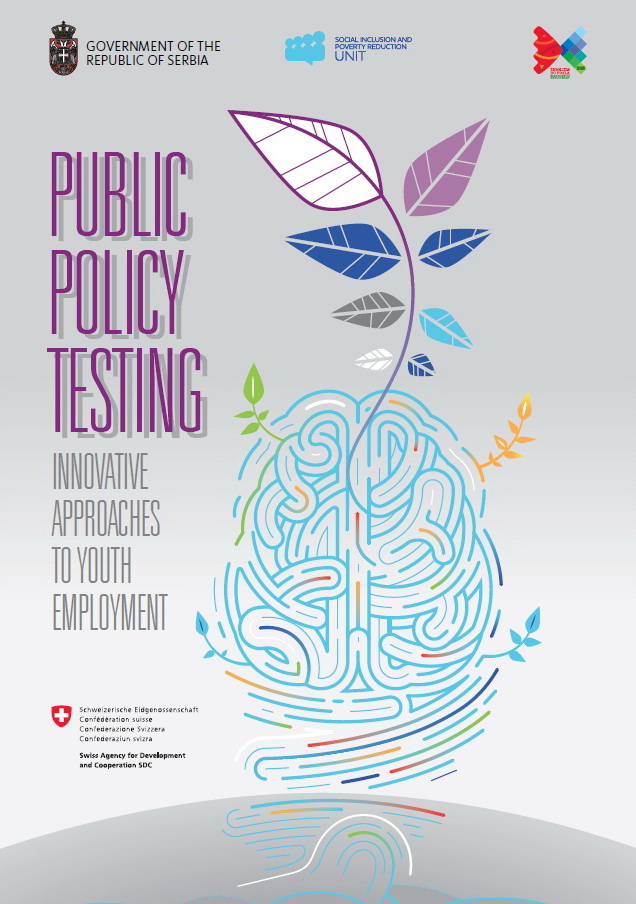 The Social Inclusion and Poverty Reduction Unit of the Government of the Republic of Serbia (hereinafter SIPRU) published a manual titled “Public Policy Testing – Innovative Approaches to Youth Employment”, which represents a practical guide to developing, testing and scaling innovative models of youth employment. The Manual was created within the project aimed at supporting the implementation of the Employment and Social Reform Programme (ESRP). This project was a part of the broader programme “Education to Employment”, which was implemented from 2015 to 2019 with the support of the Government of Switzerland.
The Social Inclusion and Poverty Reduction Unit of the Government of the Republic of Serbia (hereinafter SIPRU) published a manual titled “Public Policy Testing – Innovative Approaches to Youth Employment”, which represents a practical guide to developing, testing and scaling innovative models of youth employment. The Manual was created within the project aimed at supporting the implementation of the Employment and Social Reform Programme (ESRP). This project was a part of the broader programme “Education to Employment”, which was implemented from 2015 to 2019 with the support of the Government of Switzerland.
This Manual is intended for everyone who wants to enrich their knowledge and skills in the field of social innovation, or who wants ro develop and test solutions in the future in order to solve issues faced by a particular community or the entire society.
In this Manual, you can find more information on the SIM (Social Innovation Mechanism) instrument, which was developed and used by SIPRU first to develop innovative youth employment models, then test them in practice and finally make them sustainable at the local or national level.
The SIM instrument includes several elements, the most important being the financial programme for developing innovative models, the capacity building programme for social innovation aimed at civil society organisations, the system for monitoring and evaluating innovative models, adequate human resources, and institutional support to scaling models provided by SIPRU.
With the SIM instrument, SIPRU has provided support to 19 projects (the total value of the donation was CHF 450,000), with the participation of over 650 young people. Some of the most important achieved effects are:
- At the local level, six innovative youth employment models have been fully developed, undergoing the process of institutionalisation, upscaling and achieving sustainability.
- The employment and/or self-employment rate of young people one year after completing the programme was 58.5%.
- The Third National Report on Social Inclusion and Poverty Reduction adopted by the Government of the Republic of Serbia contains measures to resolve the issue of youth unemployment, based on experience gained in testing innovative models.
- The measure from the National Employment Action Plan titled “Training at the employer’s request” has been improved in 2018 based on an innovative model tested in Kragujevac, regarding employer obligations towards persons seeking employment after the end of the measure. Two educational programmes in the metals processing sector have been accredited and rolled out based on the same model.
- The capacities of the National Employment Service (NES) for the employment of youth with disabilities have been raised by introducing into practical use a manual for NES counsellors that significantly facilitates work with businesses and persons with disabilities based on one of the developed innovative models.
- Several local employment action plans have been amended based on experiences gained through piloting innovative models at the local level. In this way, the models have found a place in local public policies, along with the relevant funds.
- IPA 2014 project in the field of employment and active inclusion (EUR 4 million) emphasised the importance of testing public policies to improve them and included the criteria for innovation in the evaluation list used in the selection of projects to be supported.
- Civil society organisations and local self-governments that have participated in the SIM mechanism have secured an amount of nearly EUR 2 million* for improving the area of youth employment through participation in national and international public calls for awarding grants.
Each of the 6 examples of innovative youth employment models indicates that cross-sectoral cooperation and trust between the public, private, civil sector and the academia is crucial for reducing unemployment and changing the lives of young people.
Downloads:
- Public Policy Testing – Innovative Approaches to Youth Employment (.pdf)
- Public Policy Testing – Innovative Approaches to Youth Employment – Leaflet (.pdf)
——-
*The data is based on the results of a survey implemented by SIPRU among grant recipients who participated in the Social Innovation Mechanism during the period 2015-2019.
 Government of the Republic of Serbia
Government of the Republic of Serbia















 pdf [271 KB]
pdf [271 KB]
Leave a Comment